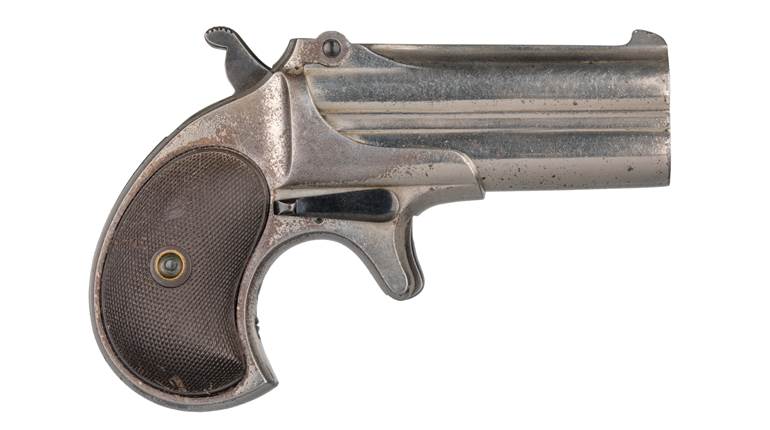
Lee was born in Scotland on August 9, 1831. His family emigrated to Canada when he was about 5 years old, and he learned the trade of watchmaking from his father. In 1859, the Lee family relocated across the American border to Wisconsin, where James Lee established a watchmaking concern along with other business enterprises. During that period, Lee also dabbled in firearm design, including a novel 40-shot repeating rifle and a single-shot carbine.

The U.S. Army Ordnance Department expressed some interest in the carbine and placed an order for 1,000 of them in 1864. Lee entered into an arrangement with the Remington Arms Co. for barrel production for his carbine. Lee, however, was unable to successfully fulfill the contract, although a small quantity was reportedly completed and privately purchased by Union officers and militia units.
Even though his initial firearm manufacturing venture was less than successful, Lee became affiliated with the Remington Arms Co. after the Civil War, and he did development work for the firm until the early 1870s. Lee left Remington and worked on several designs for submission to the U.S. Army Ordnance Department Trials held in 1872-1873. Although none of Lee’s arms were selected for consideration, another of his designs for a novel “vertical action” rifle resulted in 143 of them being fabricated by Springfield Armory. The Model 1875 Lee Vertical Action rifle proved to be a strong and reliable design, but was not deemed sufficiently superior to the standard Trapdoor Springfield to warrant further development.

During that period, Lee developed a box magazine, which was patented in 1875. The inventor envisioned that type of magazine as a safer and more reliable alternative to typical tubular magazines—which could result in dangerous accidental discharges. Lee returned to Remington, where he continued refining his magazine design. He also worked on several other types of firearms, including a bolt-action military rifle, which was patented in 1878. Remington had previously invested heavily in a bolt-action rifle, the Remington-Keene. Lee realized that there was little likelihood that the company would be interested in another bolt-action at that time.
Therefore, Lee left Remington and started a new enterprise, the Lee Arms Co., to market his new rifle. In order to manufacture it, Lee entered into a business arrangement with the Sharps Rifle Co. in Bridgeport, Conn., to utilize that firm’s offices and production facilities. The production superintendent at Sharps during that time was Hugo Borchardt, who later gained fame as the designer of several noteworthy arms, including the forerunner of the famed German Luger pistol.
Model 1879 U.S. Navy Rifles
The first rifle to be produced by the new Lee Arms Co. was the Model 1879. This bolt-action design featured the five-round detachable box magazine Lee had patented a few years earlier. In the late 1870s, a repeating bolt-action magazine rifle was still a revolutionary concept, especially compared to the obsolescent single-shot Trapdoor Springfield. Lee’s rifle had a 29.5” barrel, was 48.5” long overall and weighed about 8.5 lbs. The bolt handle was straight, and the bolt had two locking lugs; the root of the handle and a small lug on the left side that locked into an opening in the left side of the receiver. The bolt had a round cocking piece on the rear that allowed the firing pin to be manually retracted to function as a half-cock safety, and it cocked on closing. There was also a gas escape hole drilled into the left side of the receiver ring.

The Lee Model 1879 rifle was developed, at least in part, in answer to an 1876 U.S. Navy Bureau of Ordnance recommendation that “… we (the U.S. Navy) should adopt a magazine gun, which for naval purposes is in every respect preferable.” The United States had previously procured some 2,500 Hotchkiss bolt-action repeating rifles chambered for the standard .45-70 Gov’t cartridge and desired to purchase 250 of the Remington-Keene bolt-action repeating rifles also in .45-70.
The Hotchkiss design featured an internal tubular magazine in the buttstock and the Remington-Keene had a tubular under-barrel magazine. The Navy wished to procure a number of the Lee rifles with detachable box magazines in order to evaluate that magazine system against the other two types. To that end, the U.S. Navy ordered 300 Lee M1879 rifles chambered for the .45-70 cartridge in 1882.

While in the process of manufacturing the 300 Model 1879 rifles, the under-capitalized Sharps Rifle Co. fell on difficult economic times and was forced out of business. Lee once again turned to Remington and reached an agreement for the firm to utilize the 300 partially finished rifles and complete the initial Navy contract. These M1879 U.S. Navy rifles were serially numbered 1 to 300. The left side of the receivers were marked “The Lee Arms Co Bridgeport CONN USA Patented NOV 4th 1879” and were stamped “HN” (for government inspector Henry Nettleton). The barrels were stamped “WWK” (Navy inspector W.W. Kimball), and “US” with an anchor marking, denoting Navy ownership.
After the demise of Sharps, the Navy ordered an additional 700 Model 1879s, which were completed by Remington. These were in the 400 to 1,000 serial number range and were stamped “WMF” (Navy inspector William M. Folger). Early examples were still marked “THE LEE ARMS Co.” on the left side of the receiver, while later versions were marked “E. REMINGTON & SONS, ILION, NY.”

Otherwise, the “Second Contract” M1879 USN rifles were very similar to the “First Contract” with the exception of a different pattern rear sight on some examples. The M1879 rifle utilized a Remington socket bayonet that was similar to, but not interchangeable with, the M1873 Trapdoor bayonet and was the cause of some criticism in subsequent Navy reports.
The M1879 Remington-Lee rifles were issued on several U.S. Navy warships, including the U.S.S. Atlanta and U.S.S. Boston. Both the Lee Magazine rifles and Trapdoors were carried on those ships, with the latter being utilized mainly by the Marine contingent. The Lees were generally satisfactory, but some complaints were noted, including easily damaged rear sights, fragile springs, brittle firing pins and the non-standard bayonet. M1879s remained in use on several Navy ships until at least the mid-1890s.

After completion of the rifles for the U.S. Navy, Remington continued production of the Lee Magazine rifle, primarily for overseas military sales. In 1884, the Chinese government purchased approximately 4,000 M1879s chambered for the .43 Spanish cartridge. The total number of M1879 rifles manufactured is not known, but most sources agree that about 7,500 were eventually produced.
The M1879 U.S. Navy contract Lee rifles, especially the first 300 with Sharps-made receivers, are popular with collectors. Their connection with Sharps and the fact that they were the first bolt-action repeating rifles with a detachable-box magazine adopted and issued to U.S. troops make the rifles historic U.S. military collectibles.
Model 1882 Remington-Lee U.S. Army Trials Rifles
The M1879 was followed by the Model 1882, which featured a redesigned bolt-action mechanism and an improved detachable box magazine. The longer bolt handle was curved and was located to the rear of the receiver bridge. The cocking piece was changed in size and configuration, and the bolt retained the same cock-on-closing action as found on its predecessor. The M1882 action shared features of the earlier M1879 Lee and the later M1885 Remington-Lee, including a half-cock safety.
Remington was interested in entering U.S. Army trials for repeating magazine rifles and wished to submit the improved M1882 Remington-Lee. In September, 1884, the U.S. Ordnance Department purchased 750 M1882 rifles along with bayonets, cartridge belts and other accessories. The M1882 was tested along with the Chaffee-Reese and Hotchkiss repeating rifles. Ordnance Department reports indicate that 713 M1882 Remington-Lees were issued for trial in the hands of U.S. Army troops.

The U.S. Army M1882s were in the 8,801 to 9,800 serial number range and were chambered for .45-70 Gov’t. The rifle was 52” in overall length with a 32.5” barrel. The rear sight was of the M1879 Trapdoor Buckhorn pattern but was marked “R-L.” Some sources state that this marking indicated “Rifle-Lee” and others indicate that the marking stood for “Remington-Lee.” The barrels were stamped on the left side with the initials of Army inspector David F. Clark (“DFC”). A script “DFC” cartouche was also stamped on the right side of the stock. And the buttplate tang was marked “US.” Unlike the previous M1879 Lee rifle, the M1882 utilized the M1873 Trapdoor bayonet.
The three trial rifles (Remington-Lee, Chaffee-Reese and Hotchkiss) were issued to several U.S. Army infantry companies, and the reports of each unit were summarized in a December 1885 report. The Remington-Lee was the clear-cut favorite as compared with the other two, but, perhaps surprisingly, the Trapdoor was overwhelming preferred by the troops. The Army fielded relatively few of the repeating bolt-action rifles, and the Trapdoor remained the standard-issue service rifle until the adoption of the .30-40 Krag in 1892.

In 1892, approximately 200 of the M1882 Remington-Lee Army rifles remaining in inventory were transferred to the Massachusetts Naval Militia. These can be identified by the added naval militia markings and are noteworthy as they represent a rifle that was made for the U.S. Army and subsequently transferred to the auspices of the Navy. The balance of the M1882 rifles was discarded after the trials, and many were sold as surplus.
Although the only sales of M1882s to the U.S. Military were the 750 U.S. Army trial rifles, Remington had much better success with other nations, and about 32,000 were produced in 1884-1885. The Chinese government purchased approximately 7,000 M1882 rifles and carbines in both .45 and .43 caliber.
Model 1885 U.S. Navy Rifles
After undergoing a corporate reorganization, Remington introduced the Model 1885 Remington-Lee rifle to replace the Model 1882. The M1885 Navy rifle was chambered for the .45-70 Gov’t cartridge and was similar in design to the M1882 Army trial rifle, including the same type of detachable box magazine. The bolt had the same rear locking system as found on the M1882 but utilized a separate bolt head and different pattern extractor. The half-cock safety feature was retained.
The M1885 rifle weighed 9 lbs. and measured 52” in overall length with a 32.5” barrel. It was fitted with the same type of bayonets, slings, barrel bands and sights as the Trapdoor of the same period. In August, 1888, Remington received a U.S. Navy contract for 1,610 (soon increased to 1,650) M1885 Remington-Lee rifles. They were shipped to the Navy in June of 1889, and they were marked with two separate serial numbers—one by Remington and another by the Navy.

Initially, the M1885 USN rifles were fitted with the same M1879 Buckhorn rear sight (marked “R-L”) as found on the M1882 U.S. Army Trial rifles. Some subsequent M1882 USN rifles were fitted with M1884 Trapdoor Springfield Buffington rear sights. Rifles with the first-pattern sights had Navy serial numbers in the 1,001 to 2,540 range, and the rifles with the later sights were numbered in the 2,541 to 2,650 range. Remington factory serial numbers were in the 50,005 to 51,918 serial number range.
This contract was followed by a second order in June 1889 for 300 M1885 Remington-Lee U.S. Navy rifles, which had Navy serial numbers in the 2,651 to 2,950 range. Rifles manufactured under both contracts were marked “USN” and stamped with a Navy anchor insignia on the receiver ring. The rifles were also stamped “WWK” for U.S. Navy inspector Lt. W.W. Kimball.

Additional contracts were placed by the Navy, including an order for 280 rifles in April 1892 for issue to the California Naval Battalion. By this time, Lt. Kimball had been replaced by H.H. Eames, and “HHE” inspector initials replaced the “WWK” marking on the receiver ring. This contract was followed by several additional orders for rifles with which to equip various naval units and warships.
The final U.S. Navy orders for M1885 Remington-Lee rifles were placed in 1894. By this time, approximately 3,400 rifles had been procured by the Navy. Other Navy inspection markings may be found on these later rifles, including “ACD” (Lt. A.C. Diffenbach), “CEC” (unknown) “SWV” (unknown), and “HE” (possibly a variation of Lt. Eames’ inspection stamp). A few of the M1885 USN rifles were devoid of inspection initials.

The M1885 USN rifles were issued in larger numbers than either the M1879 or M1882 U.S. government contract rifles. The Navy desired the new Model 1885 Remington-Lee rifles for its newest warships coming into service, including some gunboats. The first ship to be issued M1885 USN rifles was the new cruiser U.S.S. Philadelphia which was commissioned in 1889. The following ships are known to have received varying quantities of M1885 Remington-Lee Navy rifles: U.S.S. Philadelphia; U.S.S. Monterey; U.S.S. Charleston; U.S.S. Detroit; U.S.S. San Francisco; U.S.S. Columbia; U.S.S. Vesuvius; U.S.S. Castine; U.S.S. Thetis and U.S.S. Concord.
A number of Naval Militia units were issued the M1885 rifles as well, which remained the main U.S. Navy rifles until the adoption of the Model 1895 6 mm Lee Navy straight-pull rifle, which was another design of the prolific James Paris Lee. The M1895 was manufactured by Remington’s rival, the Winchester Repeating Arms Co., and was the U.S. military’s first smokeless-powder repeating rifle.

The Winchester M1895 Lee Navy was the standard U.S. Navy and U.S. Marine Corps service rifle during the Spanish-American War of 1898. The adoption of the modern M1895 6 mm rifle spelled the end of the Remington-Lees in U.S. Navy service and, shortly after the turn of the century, the rifles were essentially a thing of the past.
Even though the bolt-action, detachable-box-magazine rifles designed by James Paris Lee saw only a modicum of use by the United States military, Lee’s design found much favor in Great Britain. A modified and refined version of Lee’s basic bolt-action, detachable-box-magazine rifle became perhaps the most venerable rifle in Great Britain’s history, the Short, Magazine Lee-Enfield. The SMLE can be directly traced back to the Remington-Lee rifles that saw action on the American Western frontier and in the racks of late 19th-century U.S. Navy warships. James P. Lee’s design was, indeed, “ahead of its time.”





































